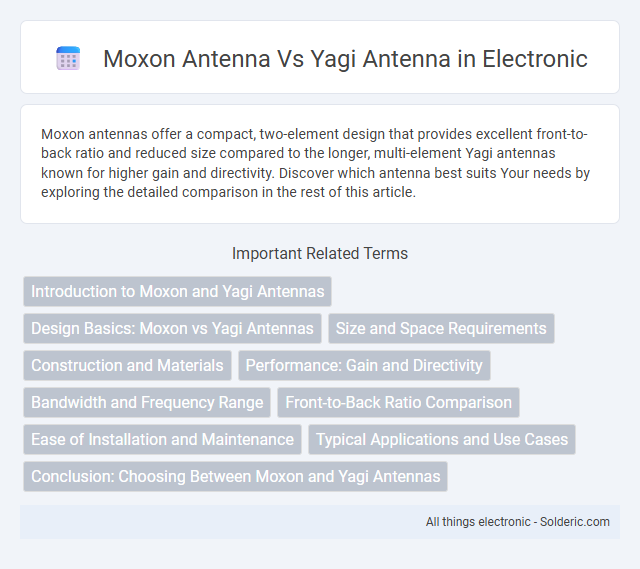Moxon antennas offer a compact, two-element design that provides excellent front-to-back ratio and reduced size compared to the longer, multi-element Yagi antennas known for higher gain and directivity. Discover which antenna best suits Your needs by exploring the detailed comparison in the rest of this article.
Comparison Table
| Feature | Moxon Antenna | Yagi Antenna |
|---|---|---|
| Design | Compact, rectangular two-element design | Multi-element directional antenna with reflector, driven element, and directors |
| Elements | 2 elements (driver and reflector) | Typically 3 to 20+ elements |
| Gain | Moderate gain (~6-7 dBi) | High gain (varies; up to 13+ dBi) |
| Size | Smaller, more compact | Larger, longer boom length |
| Front-to-Back Ratio | High front-to-back ratio (~20-30 dB) | Good to excellent (~20-30+ dB depending on design) |
| Bandwidth | Wider bandwidth | Narrower bandwidth |
| Construction | Simple, easy to build | More complex, requires precise element spacing |
| Use Case | Portable, limited space applications | Fixed installations requiring higher gain |
Introduction to Moxon and Yagi Antennas
Moxon and Yagi antennas are popular directional antennas used in amateur radio and communication systems, offering distinct design advantages. The Moxon antenna features a compact, rectangular shape with two elements optimized for a smaller footprint and good front-to-back ratio, enhancing signal clarity. In contrast, the Yagi antenna has multiple elements, including a driven element, reflector, and several directors, providing higher gain and directivity, which can improve Your long-distance signal reception and transmission.
Design Basics: Moxon vs Yagi Antennas
Moxon antennas feature a compact, rectangular design with two elements bent inward, optimizing front-to-back ratio and reducing size compared to Yagi antennas. Yagi antennas consist of a driven element, reflector, and multiple directors arranged linearly, prioritizing gain and directivity over compactness. The Moxon's simplified geometry offers easier construction and better side-lobe suppression, while Yagi designs excel in long-range signal strength and bandwidth.
Size and Space Requirements
The Moxon antenna features a compact, rectangular design that requires significantly less space compared to the longer, boom-based structure of a Yagi antenna, making it ideal for limited space installations. While a Moxon typically offers a smaller footprint due to its folding elements, Yagi antennas need more clearance for optimal performance across multiple elements. This size difference impacts installation flexibility, with Moxon antennas often preferred for portable or backyard use where space is constrained.
Construction and Materials
Moxon antennas feature a compact, rectangular design using two elements formed from lightweight aluminum or copper tubing, optimizing space and minimizing wind load. Yagi antennas consist of multiple elements including a driven element, reflectors, and directors, often constructed from aluminum rods for enhanced durability and precise directional gain. Your choice between these antennas depends on whether you prioritize a smaller footprint (Moxon) or higher gain and directivity (Yagi), influenced by their distinct structural materials and complexity.
Performance: Gain and Directivity
Moxon antennas typically offer moderate gain and a compact design, providing a forward gain of about 6 to 7 dBi with reduced side lobes for improved directivity compared to basic dipole antennas. Yagi antennas generally achieve higher gain, often ranging from 7 to 13 dBi depending on the number of elements, with superior directivity due to their multiple directors and reflectors. While Yagis excel in long-distance signal focus, Moxon antennas provide a balance of decent gain and a wider pattern, making them ideal for limited space and easier construction.
Bandwidth and Frequency Range
Moxon antennas typically offer a narrower bandwidth but exceptional gain and front-to-back ratio within the 20-meter to 70-centimeter frequency range, making them ideal for focused HF and VHF applications. Yagi antennas provide a wider bandwidth and operate efficiently across multiple bands, often covering HF, VHF, and UHF frequencies with moderate gain and directivity. The choice between Moxon and Yagi depends on the need for broader frequency coverage or enhanced performance in a specific, narrower frequency range.
Front-to-Back Ratio Comparison
The Moxon antenna typically offers a higher front-to-back ratio than the Yagi antenna, often exceeding 20 dB compared to the Yagi's average 10-15 dB, which improves signal rejection from the rear. This enhanced front-to-back ratio makes the Moxon ideal for reducing interference and enhancing directionality in crowded frequency environments. Choosing the Moxon antenna can optimize your signal clarity and communication reliability by minimizing unwanted noise behind the antenna.
Ease of Installation and Maintenance
The Moxon antenna offers easier installation due to its compact, lightweight design, requiring fewer support structures compared to the Yagi antenna. Your maintenance efforts are minimized with the Moxon's simpler construction and durable materials, reducing the likelihood of damage. In contrast, the Yagi antenna's multiple elements and larger size demand more complex setup and frequent upkeep.
Typical Applications and Use Cases
Moxon antennas excel in portable and limited-space setups, often used for amateur radio contests, field operations, and compact HF bands due to their smaller size and good front-to-back ratio. Yagi antennas are preferred for long-distance communication, such as DXing and fixed station use, offering higher gain and directional control on VHF and UHF frequencies. Your choice depends on whether portability or maximum signal gain and directionality better suit your radio communication needs.
Conclusion: Choosing Between Moxon and Yagi Antennas
Moxon antennas offer a compact, lightweight design with excellent front-to-back ratio and good gain, making them ideal for limited space and portable applications. Yagi antennas typically provide higher gain and greater directivity, suited for long-distance communication and fixed installations. Selecting between Moxon and Yagi antennas depends on specific requirements such as available space, desired gain, weight constraints, and target communication range.
moxon antenna vs yagi antenna Infographic

 solderic.com
solderic.com